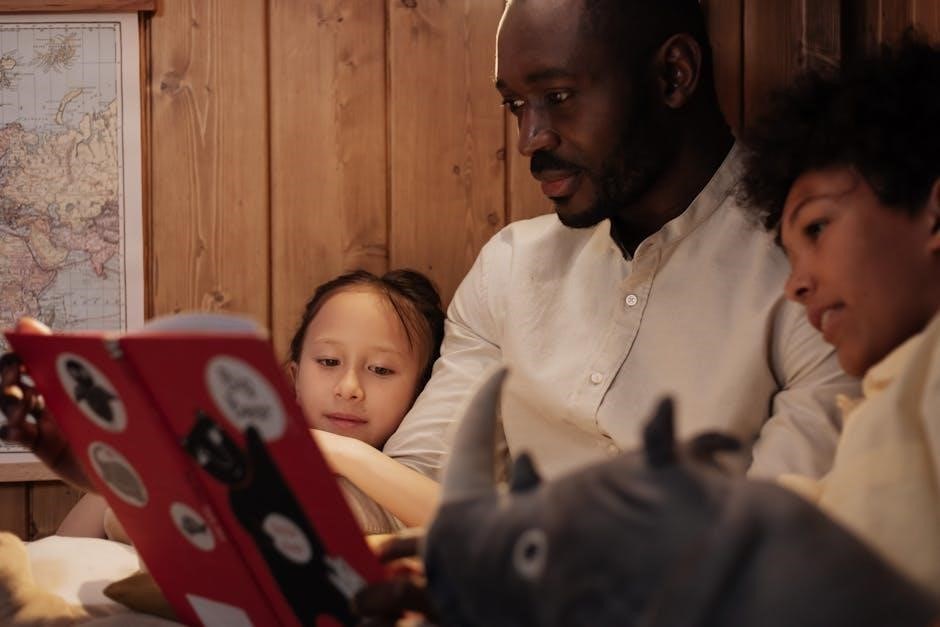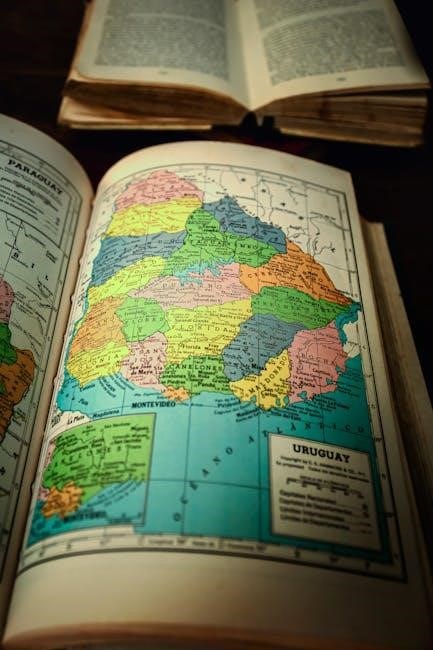the culture map book pdf

The Culture Map book PDF is a valuable resource for understanding cultural dynamics in global business. It offers insights into navigating cultural differences, enhancing collaboration, and improving leadership across borders. Erin Meyer’s work provides practical tools for decoding cultural cues, making it essential for professionals in international business. The digital format ensures accessibility and convenience for readers worldwide.
1.1 Overview of the Book
The Culture Map by Erin Meyer is a comprehensive guide to understanding cultural differences in global business. The book introduces the Culture Map framework, which helps decode the invisible cultural dynamics that influence how people lead, negotiate, and collaborate across borders. Meyer, an expert in cross-cultural management, provides insights into eight key cultural dimensions, including communication, evaluation, and decision-making. Through real-world examples and practical advice, the book equips readers with the tools to navigate cultural misunderstandings and build stronger relationships in international business. The PDF version of the book is widely available, offering a convenient format for professionals and students to access Meyer’s valuable insights anytime, anywhere. This resource is indispensable for anyone seeking to enhance their cultural intelligence and succeed in today’s globalized world.
1.2 Importance of Cultural Intelligence in Global Business

Cultural intelligence is essential for navigating the complexities of global business, as highlighted in The Culture Map. In today’s interconnected world, understanding cultural differences is no longer optional but a critical skill for success. Erin Meyer emphasizes how cultural dynamics shape leadership, communication, and collaboration. Without cultural intelligence, misunderstandings can lead to failed negotiations, strained relationships, and missed opportunities. The book provides practical tools to decode these differences, enabling professionals to build trust and foster effective teamwork across borders. By mastering cultural intelligence, leaders can adapt their strategies to diverse environments, ensuring smoother interactions and better outcomes. Meyer’s insights are invaluable for anyone working in international business, making The Culture Map a must-read for global professionals aiming to thrive in a multicultural world.
1.3 Author Erin Meyer and Her Expertise
Erin Meyer is a renowned professor at INSEAD, specializing in cross-cultural management, and a leading expert in global business dynamics. Her work focuses on helping leaders navigate cultural differences to enhance collaboration and decision-making. Meyer’s expertise is rooted in extensive research across diverse cultures, providing actionable insights for professionals in international settings. Her book, The Culture Map, is a testament to her deep understanding of cultural nuances, offering practical frameworks for overcoming communication barriers. Meyer’s contributions have made her a sought-after speaker and consultant, aiding organizations worldwide in fostering cross-cultural understanding. Her unique approach blends academic rigor with real-world applications, making her a trusted authority in the field of global business and cultural intelligence.

Key Concepts and Frameworks in The Culture Map
The book introduces eight cultural dimensions, including communication, evaluation, leadership, and time perception, offering a framework to navigate differences in global business. Meyer’s insights provide practical tools for cross-cultural collaboration.
2.1 The Eight Cultural Dimensions

Erin Meyer’s Culture Map outlines eight critical dimensions of cultural differences: communication, evaluation, leadership, decision-making, trust, time, context, and persuasion. These dimensions help professionals understand and navigate cross-cultural interactions effectively. The framework provides a clear roadmap for decoding behaviors, expectations, and values across diverse cultures, ensuring more effective collaboration and communication in global teams. By examining these dimensions, readers gain insights into how cultural preferences influence workplace dynamics, enabling them to adapt their strategies to suit different cultural contexts. This structured approach is invaluable for leaders and teams aiming to bridge cultural gaps and achieve alignment in multinational environments.
2.2 Communication Styles Across Cultures
Communication styles vary significantly across cultures, as highlighted in The Culture Map. Erin Meyer distinguishes between high-context and low-context cultures, where communication is either implicit or explicit. High-context cultures, like those in the Middle East or Asia, rely on non-verbal cues and shared knowledge, while low-context cultures, such as Germany or the U.S., prefer direct and explicit communication. Additionally, Meyer explores formal versus informal communication and the role of hierarchy in shaping interactions. Understanding these differences is crucial for effective global collaboration, as miscommunication can arise from contrasting expectations. The book provides practical advice on adapting communication styles to bridge cultural gaps, ensuring clarity and mutual understanding in diverse teams. This insight is invaluable for professionals navigating international business environments.
2.3 Evaluation and Feedback in Different Cultures

In The Culture Map, Erin Meyer explores how evaluation and feedback practices vary across cultures. Some cultures, like the U.S., value direct and explicit feedback, while others, such as in Japan or India, prefer subtlety and indirectness to maintain harmony. Meyer highlights the importance of understanding these differences to avoid misunderstandings. For example, in low-context cultures, blunt criticism is often seen as constructive, whereas in high-context cultures, it may be perceived as disrespectful. The book provides practical strategies for adapting feedback styles to cultural norms, ensuring clarity and fostering trust. This insight helps global professionals navigate the complexities of evaluation and feedback, enabling more effective collaboration and growth across cultural boundaries. Meyer’s framework is essential for leaders seeking to build inclusive and supportive international teams.
2.4 Leadership Styles and Cultural Expectations
Erin Meyer’s The Culture Map delves into how leadership styles vary significantly across cultures. In some societies, leaders are expected to adopt a hierarchical, authoritative approach, while others prefer a more egalitarian, participative style. Meyer explains that these differences stem from cultural values, such as power distance and individualism versus collectivism. For instance, in Japan, leaders often maintain a reserved, humble demeanor, while in the U.S., assertiveness and charisma are highly valued. Understanding these expectations is crucial for effective cross-cultural leadership. Meyer provides practical advice on adapting leadership behaviors to align with cultural norms, ensuring respect and productivity in global teams. This framework helps leaders bridge cultural gaps, fostering trust and collaboration across diverse workplaces. Meyer’s insights are invaluable for anyone navigating the complexities of international leadership.
2.5 Decision-Making Processes in Global Teams
In The Culture Map, Erin Meyer explores how decision-making processes vary across cultures, impacting global collaboration. Some cultures, like Japan, emphasize consensus-building, while others, such as the U.S;, prioritize individual responsibility and rapid decision-making. Meyer highlights the importance of understanding these differences to avoid misunderstandings. For instance, in hierarchical cultures, decisions often come from top leaders, whereas in egalitarian societies, team input is valued. Meyer provides practical strategies for balancing speed and inclusivity, ensuring all voices are heard while maintaining efficiency. Her framework helps global teams navigate these complexities, fostering alignment and trust. By addressing these cultural nuances, Meyer equips leaders with tools to make informed, collaborative decisions in diverse environments. This insight is crucial for thriving in today’s interconnected business world.
2.6 Building Trust Across Cultural Boundaries
Building trust across cultural boundaries is a cornerstone of effective global collaboration, as explored in The Culture Map. Erin Meyer highlights that trust is built differently across cultures, with some emphasizing personal relationships and others focusing on professionalism and competence; For example, in Latin American cultures, trust often stems from personal connections, while in Scandinavian cultures, it arises from transparency and fairness. Meyer’s framework provides practical strategies for navigating these differences, such as understanding the balance between task-oriented and relationship-oriented trust. By recognizing these cultural nuances, leaders can foster trust in diverse teams, ensuring stronger collaboration and mutual respect. Meyer’s insights are invaluable for anyone aiming to bridge cultural gaps and build enduring trust in global business environments. Her approach helps leaders adapt their behaviors to align with cultural expectations, fostering unity and productivity across borders. This understanding is essential for thriving in today’s interconnected world.
2.7 Time Perception and Scheduling Differences
In The Culture Map, Erin Meyer explores how time perception and scheduling vary significantly across cultures. While some cultures, like those in Northern Europe, value punctuality and rigid schedules, others, such as in Latin America, adopt a more flexible approach to time. Meyer explains that these differences can lead to misunderstandings in global business, where delays or strict deadlines may be misinterpreted. She provides practical advice on navigating these disparities, such as adjusting meeting times and deadlines to accommodate cultural norms.
Meyer’s framework emphasizes the importance of understanding these variations to avoid conflict and improve collaboration. By recognizing and respecting differing attitudes toward time, leaders can foster more harmonious and productive global teams. This insight is crucial for effective cross-cultural communication and teamwork.
2.8 The Role of Context in Communication
In The Culture Map, Erin Meyer emphasizes the role of context in shaping communication styles across cultures. She distinguishes between high-context and low-context cultures, where high-context cultures rely heavily on shared knowledge and implicit messages, while low-context cultures prefer explicit and direct communication. Meyer provides examples of how misunderstandings can arise when individuals from different cultural backgrounds interact without recognizing these differences. For instance, a direct communicator may find a high-context approach vague, while a high-context communicator may view directness as disrespectful. Meyer’s insights help readers decode these nuances, enabling more effective cross-cultural interactions and fostering collaboration in global teams. Understanding context’s role is essential for navigating communication challenges in diverse workplace settings.

Practical Applications of The Culture Map
The Culture Map offers real-world strategies for decoding cultural cues, improving collaboration, and enhancing effectiveness in international business. Its insights are invaluable for global teams and leaders.
3.1 Navigating Cultural Differences in Negotiations
In The Culture Map, Erin Meyer provides actionable strategies for navigating cultural differences in negotiations. The book highlights the importance of understanding cultural dimensions, such as communication styles and decision-making processes, to avoid misunderstandings. Meyer emphasizes the need to adapt approaches based on cultural contexts, ensuring effective and respectful interactions. By decoding cultural cues, readers can build stronger relationships and achieve successful outcomes in global negotiations. Practical examples and frameworks enable professionals to tailor their strategies to diverse cultural settings, fostering collaboration and trust. This section is particularly valuable for those engaged in international business, offering insights to navigate the complexities of cross-cultural negotiations with confidence and sensitivity.
3.2 Improving Collaboration in Multicultural Teams
The Culture Map offers practical advice for improving collaboration in multicultural teams by addressing cultural differences in communication, decision-making, and trust-building. Erin Meyer emphasizes the importance of understanding how diverse cultural backgrounds influence team dynamics. By recognizing and respecting these differences, leaders can foster an inclusive environment where all members feel valued. Meyer provides strategies for aligning team goals, encouraging open dialogue, and leveraging diverse perspectives to enhance innovation. The book also highlights the role of context in communication, helping teams navigate potential misunderstandings. These insights enable professionals to build stronger, more cohesive teams, ensuring effective collaboration across cultural boundaries. The frameworks and examples provided make it an invaluable resource for managing global teams successfully.
3.3 Avoiding Common Cultural Misunderstandings
The Culture Map equips readers with essential tools to avoid cultural misunderstandings that can hinder global business interactions. Erin Meyer identifies key areas where miscommunication often occurs, such as variations in communication styles, feedback methods, and decision-making processes. She provides actionable strategies to recognize and navigate these differences, emphasizing the importance of cultural awareness. By understanding the cultural maps of different nations, professionals can anticipate potential pitfalls and adapt their approaches accordingly. Meyer’s real-world examples illustrate how minor cultural oversights can lead to significant conflicts, making her guidance invaluable for fostering mutual respect and effective collaboration in multicultural settings. This section is crucial for anyone seeking to build strong, culturally sensitive relationships in international business environments.

3.4 Adapting Leadership Styles to Cultural Contexts
The Culture Map emphasizes the importance of adapting leadership styles to align with cultural expectations. Erin Meyer highlights how different cultures perceive leadership, ranging from hierarchical to egalitarian structures. She introduces frameworks to help leaders recognize these differences and adjust their approaches. For instance, in some cultures, a top-down decision-making style is preferred, while others value consensual approaches. Meyer provides practical advice on how to navigate these variations, ensuring leaders can inspire and motivate teams across diverse cultural landscapes. By understanding and adapting to these cultural nuances, leaders can foster trust, collaboration, and productivity within global teams. This section is a cornerstone for anyone aiming to refine their leadership skills in multinational environments. Meyer’s insights are invaluable for creating inclusive and effective leadership strategies worldwide.

Erin Meyer’s Research and Contributions
Erin Meyer, a renowned expert in cross-cultural management, developed the Culture Map framework, offering insights into global business dynamics. Her research at INSEAD has significantly influenced international leadership practices.
4.1 Meyer’s Background and Work at INSEAD
Erin Meyer, a leading expert in cross-cultural management, is a professor at INSEAD, one of the world’s top business schools. Her groundbreaking research focuses on global leadership and cultural dynamics, providing actionable insights for professionals navigating international environments. Meyer’s work at INSEAD has been instrumental in developing the Culture Map framework, a tool designed to decode cultural differences and improve collaboration across borders. Her research spans numerous countries, offering a comprehensive understanding of how cultural nuances impact business practices. Meyer’s expertise has made her a sought-after speaker and consultant, helping organizations bridge cultural gaps effectively. Her contributions have significantly influenced global business strategies, emphasizing the importance of cultural intelligence in leadership.
4.2 Real-World Examples from the Book
Erin Meyer enriches The Culture Map with compelling real-world examples, illustrating how cultural differences impact global business. For instance, she compares German directness with French subtlety in communication, highlighting how misalignment can lead to misunderstandings. Meyer also explores feedback styles, showing how Americans tend to sandwich criticism between praise, while the British often understate negative feedback. One notable example involves a multicultural team in Brazil struggling with decision-making processes, where Meyer’s framework helped resolve conflicts. These examples, drawn from her extensive research, demonstrate the practical application of her Culture Map framework, making it a valuable resource for professionals navigating cross-cultural challenges. Her insights are supported by case studies from various industries, further emphasizing the importance of cultural intelligence in global collaboration.
4.3 Meyer’s Framework for Cross-Cultural Success
Erin Meyer’s framework, as outlined in The Culture Map, provides a structured approach to understanding and navigating cultural differences. She identifies eight key dimensions—such as communication, evaluation, and leadership—that vary across cultures. Meyer’s model helps professionals decode these differences, enabling more effective collaboration. By mapping cultures on a spectrum, her framework offers practical strategies for adapting behaviors, whether leading a team or negotiating across borders. For example, understanding where a culture falls on the direct vs. indirect communication scale can prevent misunderstandings. Meyer’s tools, such as the online Culture Map available on her website, allow users to compare countries and tailor their approaches. This framework is a cornerstone for achieving cross-cultural success in global business environments.

The Culture Map PDF and Digital Availability
The Culture Map book is widely available in PDF format, offering readers convenience and accessibility. It can be downloaded or streamed from various online platforms, ensuring easy access to Erin Meyer’s insights on cross-cultural dynamics.
5.1 How to Access the PDF Version
To access The Culture Map book in PDF format, visit trusted online platforms like official book websites or reputable eBookstores. Search for the title on platforms such as Amazon, Google Books, or academic databases. Ensure the source is reliable to avoid unauthorized downloads; Once found, follow the prompts to purchase or download the PDF. Some platforms may require an account or payment. After downloading, the file can be easily accessed on various devices, making it convenient for reading and reference. The PDF version is ideal for professionals and students seeking portability and quick access to Erin Meyer’s insights on cross-cultural business strategies.
5.2 Benefits of the Digital Format for Readers
The digital format of The Culture Map offers numerous advantages for readers. It provides instant access to the content, allowing professionals and students to quickly reference key concepts. The search functionality in PDFs enables users to locate specific topics, such as cultural dimensions or leadership styles, with ease. Portability is another benefit, as the PDF can be stored on multiple devices, making it ideal for on-the-go reading. Additionally, digital versions often include hyperlinks to resources or tools on Erin Meyer’s website, enhancing the learning experience. The digital format is environmentally friendly and cost-effective, appealing to those who prefer e-books over physical copies. These features make the PDF version a practical choice for global business professionals seeking to improve their cultural intelligence.
5.3 Tools and Resources on Erin Meyer’s Website
Erin Meyer’s website offers a variety of tools and resources to complement The Culture Map book. One of the most notable features is the ability to compare cultural maps of different countries, providing a visual representation of cultural dimensions. Users can access interactive charts and quizzes to assess their cultural intelligence and understanding. Additionally, the website includes downloadable resources, such as summaries and frameworks, to help apply the concepts in real-world scenarios. Meyer also provides updates, articles, and case studies to keep readers informed about the latest developments in cross-cultural business practices. These tools make The Culture Map a comprehensive resource for professionals and educators seeking to enhance their global collaboration skills. The website acts as a hub for ongoing learning and practical application of the book’s insights.

Educational and Professional Value
The Culture Map book PDF is a vital resource for both education and professional development, offering insights into cross-cultural dynamics. It’s widely used in international business education and corporate training, enhancing global collaboration skills and fostering cultural understanding.
6.1 The Book’s Relevance to International Business
The Culture Map book PDF is highly relevant to international business, offering a roadmap for navigating cultural differences. It provides insights into communication styles, decision-making, and trust-building across borders. Meyer’s framework helps professionals decode cultural cues, enabling smoother collaborations and leadership in global teams. The book’s practical strategies and real-world examples make it indispensable for anyone working in multinational environments. Its digital availability ensures accessibility, allowing professionals to apply its lessons in diverse business contexts. By bridging cultural gaps, The Culture Map empowers leaders to drive success in an increasingly interconnected world. Its relevance lies in its ability to transform cultural differences into opportunities for innovation and growth.
6.2 Using The Culture Map in Academic Settings
The Culture Map book PDF is a valuable resource in academic settings, aiding students and educators in understanding global business dynamics. It provides a framework for analyzing cultural differences, enriching international business curricula. The book’s practical examples and research-based insights make it ideal for classroom discussions and case studies. Educators can use its concepts to prepare students for global careers, while students gain a deeper understanding of cross-cultural collaboration. The digital format facilitates easy access and distribution, making it a versatile tool for both teaching and learning. By integrating The Culture Map into academic programs, institutions can foster culturally intelligent graduates ready to thrive in diverse business environments.
6.3 Applying the Framework in Corporate Training
The Culture Map book PDF serves as an invaluable resource for corporate training, helping organizations bridge cultural gaps in global teams. Erin Meyer’s framework provides practical insights into communication, leadership, and decision-making across cultures, enabling employees to collaborate more effectively. The book’s real-world examples and actionable strategies make it ideal for training programs focused on cross-cultural competence. By incorporating The Culture Map into corporate training, companies can enhance employees’ cultural awareness, improve teamwork, and strengthen international partnerships. The digital format allows easy distribution and accessibility, ensuring all team members can benefit from Meyer’s expertise. This approach not only fosters a more inclusive work environment but also equips employees with the skills needed to navigate the complexities of global business successfully.
The Culture Map book PDF is a transformative guide for global business, offering practical insights into cultural differences. Erin Meyer’s framework empowers professionals to navigate cross-cultural challenges effectively, fostering collaboration and understanding. The book’s accessible digital format ensures its wisdom reaches a broad audience, making it indispensable for anyone working in a globalized world.
7.1 The Impact of The Culture Map on Global Business Practices
The Culture Map has profoundly influenced global business practices by providing a framework to navigate cultural differences effectively. Erin Meyer’s insights into communication, leadership, and decision-making styles across cultures have empowered professionals to lead and collaborate more effectively. The book’s practical advice, supported by real-world examples, has become a cornerstone for cross-cultural training and negotiations. By fostering mutual understanding, it has helped organizations adapt their strategies to thrive in diverse international markets. The Culture Map book PDF has become an indispensable resource for global teams, enabling them to bridge cultural gaps and enhance their effectiveness in a interconnected world.
7.2 Encouragement for Readers to Explore Cultural Differences
The Culture Map encourages readers to embrace cultural diversity by providing practical tools to navigate global interactions. Erin Meyer’s insights inspire professionals to explore and understand the nuances of cultural differences, fostering empathy and collaboration. The book motivates readers to adapt their communication and leadership styles, ensuring effective cross-border interactions. By highlighting real-world examples, Meyer empowers individuals to bridge cultural gaps, leading to stronger relationships and successful business outcomes. The Culture Map book PDF serves as a catalyst for personal and professional growth, urging readers to actively engage with cultural differences and thrive in an increasingly interconnected world. This encouragement is vital for anyone aiming to excel in global business environments.